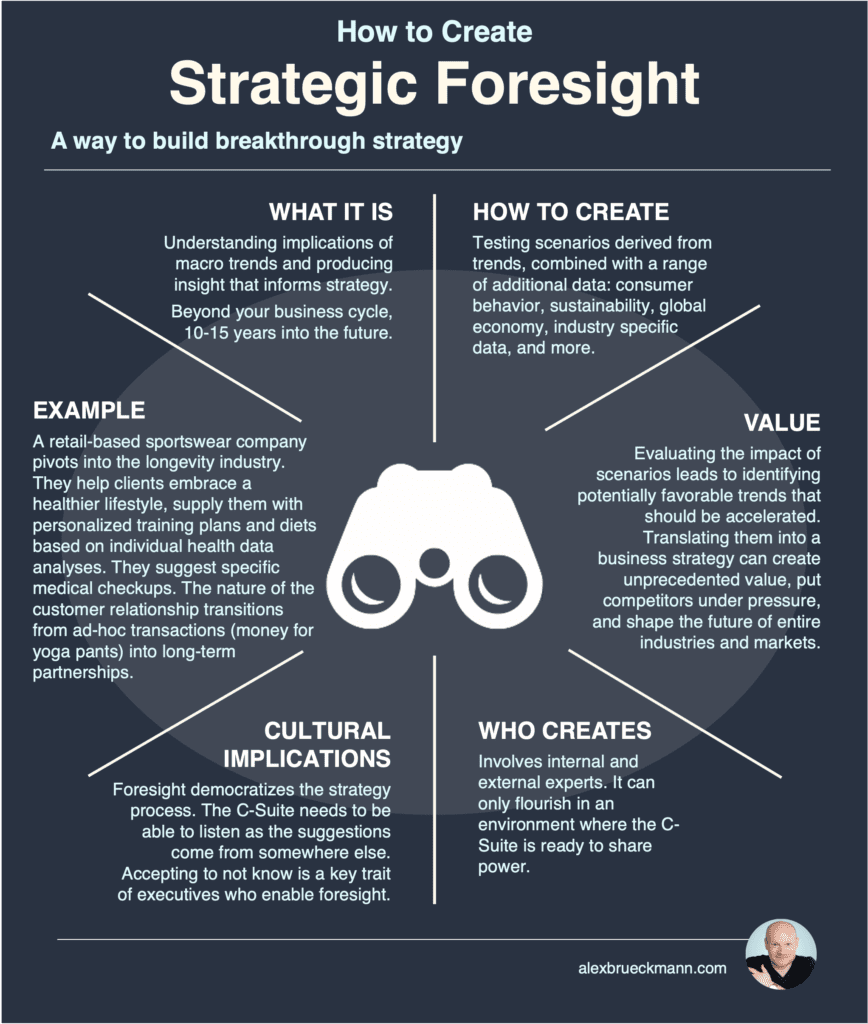A business strategy typically addresses a mid-term time horizon, often three to five years. Here’s the issue: the shorter the timeframe, the less likely will your strategy create real competitive advantage. Winning in your market requires you to look beyond the immediate strategy cycle. To define the big bets.
Foresight involves understanding longer-term developments beyond your business or industry, 10 to even 15 years into the future. Understanding these developments and translating them into business strategy can create unprecedented value, put competitors under pressure, and shape the future of entire industries.
Defining the Big Bets
A starting point to develop foresight are reports containing information on demographics, technology, economic development, consumer trends. Add interviews with experts and researchers, a mix of qualitative and quantitative data. These more generic reports are typically available for purchase.
Industry or segment-specific foresight often needs to be developed by businesses on their own. Organizations can create scenarios by combining and structuring internal and external data and running simulations. The scenarios receive a probability tag and inform a business’s long-term strategic trajectory. They become the bigger bets.

For example, let’s say you are a sportswear company. Foresight will help you shape your brand and product strategy beyond your current strategy. You aim to understand the influence of mega-trends such as urbanization and health. You investigate technological developments like wearable usage or blockchain. You throw population growth and other data into the mix and derive scenarios.
The sportswear example includes how people will do and consume sports, virtually and physically. Another field would be sustainability, interpreting what consumers will accept regarding materials or a product’s environmental and social footprint.
Foresight requires shared leadership
Foresight democratizes the strategy process. The C-Suite needs to be able to listen as suggestions come from somewhere other than their own discussions. Accepting to not know is a key trait of executives who enable foresight.
Through exploring scenarios and deriving specific information, you identify concrete projects. These projects help you dive deeper into the matter, gather additional insight, and learn as an organization. Projects also serve as reality checks, whether you might be onto something bigger.
You define a pilot and aim to accelerate a certain trend that is beneficial for you. As a result, you might consider adjusting your market positioning and the longer-term strategic trajectory of your organization.
From yoga pants to longevity
Up until now, you might have been in the business of selling yoga wear, predomi- nantly to women, in a retail environment. Based on foresight, you decide to pivot from a clothing company to a player in the longevity industry.
You help your clients embrace a healthier lifestyle. You supply them with personalized training plans and diets based on extensive AI-backed data analyses. You might even suggest specific medical checkups. The nature of your customer relationship transitions from ad hoc transactions, like money for yoga pants, into long-term partnerships.
Foresight helps you identify the best options out of myriad possibilities. You silence the ever-nagging fear of missing out. It helps you remove everything you identify as irrelevant, to avoid wasting resources on topics that don’t matter.
Without foresight to inform your strategy, you might have decided to grow your business by entering additional geographic markets, adding a yoga line for men, and diversifying your sales channels from retail to mobile sales.
There’s nothing wrong with that. However, it wouldn’t have allowed you to revolutionize your business and tap into the full potential of your customer relationships.
📌 Try my free newsletter From the Strategy Room
Join thousands of readers and subscribe here. You’ll get access to 30+ of my most popular info sheets on strategy, leadership, performance, and more.
Main image by Michał Parzuchowski

